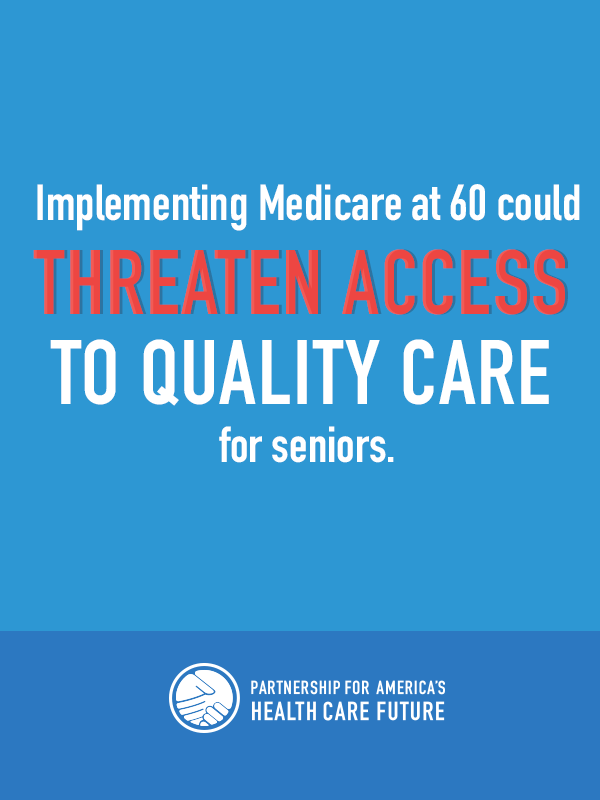New Issue Brief: ‘Medicare At 60’ Costs And Consequences For Senior Care

WASHINGTON – With the introduction of government proposals to open the Medicare program up to younger Americans, a new issue brief by Lanhee J. Chen, Ph.D., Tom Church and Daniel L. Heil provides the latest evidence of the unaffordable costs and negative consequences of “Medicare at 60.”
The issue brief, which was supported by the Partnership for America’s Health Care Future, concludes that “Medicare at 60” would absorb a majority of newly eligible Americans aged 60 to 64 years old – most of whom would otherwise be covered by private plans, such as employer-provided coverage – with Medicare expenditures likely to rise significantly as a result.
With Medicare’s trustees already warning that the program is at risk for today’s seniors and its Hospital Insurance (HI) Trust Fund projected to be depleted by 2026 under current law, Chen, Church and Heil caution that implementing “Medicare at 60”in 2022 would “hasten the depletion of the trust fund” and could cause its bankruptcy by 2024, two years sooner than currently projected.
Lowering the Medicare eligibility age to 60 may also encourage many Americans to retire earlier, which “would affect the federal budget, reducing income and payroll tax revenue,” the authors write.
The issue brief finds if traditional Medicare rules were applied to the “Medicare at 60” population:
- In 2018, as many as 16.9 million of 18.2 million 60- to 64-year-olds who were not enrolled in Medicare would have enrolled in Medicare at 60.
- Medicare would serve as the primary payer for as many as 11.1 million of this group.
- Among this population, average Medicare-related expenditures were $8,400 in 2018. Assuming no change in average expenditures, the already-at-risk Medicare program could be forced to pay as much as $5,700 per new enrollee.
- With “Medicare at 60” implemented in 2022, the Hospital Insurance (HI) Trust Fund would likely be depleted in 2024 unless policymakers adopt alternative financing methods for the new Part A expenditures.
- Future analysis is needed to determine the more extensive effects this would have on the budget, cuts to health care providers, and disruption to current health care law and programs – among other considerations – and more research is expected to follow on these important topics.
Meanwhile, our nation’s health care system is working together to expand access to coverage and care, and a new analysis by the Kaiser Family Foundation (KFF) finds that “the number of people eligible for a subsidy to purchase Marketplace coverage has increased 20 percent from 18.1 million to 21.8 million with passage of” the American Rescue Plan Act (ARPA), while “the majority of uninsured people (63 percent) are now eligible for financial assistance through the Marketplaces, Medicaid, or Basic Health Plans. In fact, more than four out of 10 uninsured people are eligible for a free or nearly free health plan through one of these programs.”
The Associated Press reports that ARPA represents “the biggest expansion of federal help for health insurance since the Obama-era Affordable Care Act,” and separate steps are already underway to extend open enrollment in the federal health care marketplace, eliminate ineffective red tape that can prevent Americans from accessing coverage options and urge the Supreme Court to uphold the Affordable Care Act.
With our health care system already working together to help Americans get healthy and stay healthy, this is not the time for one-size-fits-all proposals such as “Medicare at 60,” Medicare buy-in or the public option, which could ultimately lead to many of the same consequences as Medicare for All. Instead, our leaders should work together to build on and improve what’s working, where private coverage, Medicare and Medicaid work together to expand access to coverage and care in order to lower costs, protect patient choice, expand access, improve quality and foster innovation.
- To read the full issue brief by issue brief by Lanhee J. Chen, Ph.D., Tom Church and Daniel L. Heil, CLICK HERE.
- To learn more about the Partnership for America’s Health Care Future, CLICK HERE.